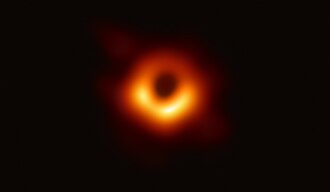
Back Supermassiewe swartkolk Afrikaans ثقب أسود فائق الكتلة Arabic محفر كحل مݣضر ARY Furacu negru supermasivu AST Lobang item gedé betul BEW Свръхмасивна черна дупка Bulgarian Forat negre supermassiu Catalan Obří černá díra Czech Supermassereiches Schwarzes Loch German Pezega nigra truo Esperanto

A supermassive black hole (SMBH or sometimes SBH)[a] is the largest type of black hole, with its mass being on the order of hundreds of thousands, or millions to billions, of times the mass of the Sun (M☉). Black holes are a class of astronomical objects that have undergone gravitational collapse, leaving behind spheroidal regions of space from which nothing can escape, including light. Observational evidence indicates that almost every large galaxy has a supermassive black hole at its center.[5][6] For example, the Milky Way galaxy has a supermassive black hole at its center, corresponding to the radio source Sagittarius A*.[7][8] Accretion of interstellar gas onto supermassive black holes is the process responsible for powering active galactic nuclei (AGNs) and quasars.[9]
Two supermassive black holes have been directly imaged by the Event Horizon Telescope: the black hole in the giant elliptical galaxy Messier 87 and the black hole at the Milky Way's center (Sagittarius A*).[10][11]
- ^ Overbye, Dennis (April 10, 2019). "Black Hole Picture Revealed for the First Time – Astronomers at last have captured an image of the darkest entities in the cosmos – Comments". The New York Times. Retrieved April 10, 2019.
- ^ The Event Horizon Telescope Collaboration (April 10, 2019). "First M87 Event Horizon Telescope Results. I. The Shadow of the Supermassive Black Hole". The Astrophysical Journal Letters. 875 (1): L1. arXiv:1906.11238. Bibcode:2019ApJ...875L...1E. doi:10.3847/2041-8213/ab0ec7.
- ^ The Event Horizon Telescope Collaboration; Akiyama, Kazunori; Alberdi, Antxon; Alef, Walter; Asada, Keiichi; Azulay, Rebecca; Baczko, Anne-Kathrin; Ball, David; Baloković, Mislav; Barrett, John; Bintley, Dan; Blackburn, Lindy; Boland, Wilfred; Bouman, Katherine L.; Bower, Geoffrey C. (April 10, 2019). "First M87 Event Horizon Telescope Results. V. Physical Origin of the Asymmetric Ring". The Astrophysical Journal. 875 (1): See especially Fig. 5. arXiv:1906.11242. Bibcode:2019ApJ...875L...5E. doi:10.3847/2041-8213/ab0f43. hdl:10150/633753. ISSN 2041-8213. S2CID 145894922.
- ^ The Real Science of the EHT Black Hole, May 2019, retrieved August 10, 2023. t = 8min
- ^ Kormendy, John; Richstone, Douglas (1995), "Inward Bound—The Search For Supermassive Black Holes In Galactic Nuclei", Annual Review of Astronomy and Astrophysics, 33: 581, Bibcode:1995ARA&A..33..581K, doi:10.1146/annurev.aa.33.090195.003053
- ^ Kormendy, John; Ho, Luis (2013). "Coevolution (Or Not) of Supermassive Black Holes and Host Galaxies". Annual Review of Astronomy and Astrophysics. 51 (1): 511–653. arXiv:1304.7762. Bibcode:2013ARA&A..51..511K. doi:10.1146/annurev-astro-082708-101811. S2CID 118172025.
- ^ Ghez, A.; Klein, B.; Morris, M.; Becklin, E (1998). "High Proper-Motion Stars in the Vicinity of Sagittarius A*: Evidence for a Supermassive Black Hole at the Center of Our Galaxy". The Astrophysical Journal. 509 (2): 678–686. arXiv:astro-ph/9807210. Bibcode:1998ApJ...509..678G. doi:10.1086/306528. S2CID 18243528.
- ^ Schödel, R.; et al. (2002). "A star in a 15.2-year orbit around the supermassive black hole at the centre of the Milky Way". Nature. 419 (6908): 694–696. arXiv:astro-ph/0210426. Bibcode:2002Natur.419..694S. doi:10.1038/nature01121. PMID 12384690. S2CID 4302128.
- ^ Frank, Juhan; King, Andrew; Raine, Derek J. (January 2002). "Accretion Power in Astrophysics: Third Edition". Accretion Power in Astrophysics. Cambridge, UK: Cambridge University Press. Bibcode:2002apa..book.....F. ISBN 0521620538.
- ^ Overbye, Dennis (May 12, 2022). "Has the Milky Way's Black Hole Come to Light? - The Event Horizon Telescope reaches again for a glimpse of the "unseeable."". The New York Times. Retrieved May 12, 2022.
- ^ updated, Robert Lea last (May 11, 2022). "Sagittarius A*: The Milky Way's supermassive black hole". Space.com. Retrieved October 29, 2023.
Cite error: There are <ref group=lower-alpha> tags or {{efn}} templates on this page, but the references will not show without a {{reflist|group=lower-alpha}} template or {{notelist}} template (see the help page).